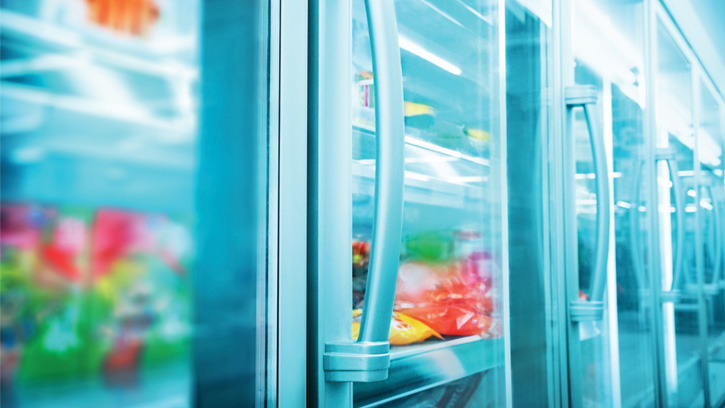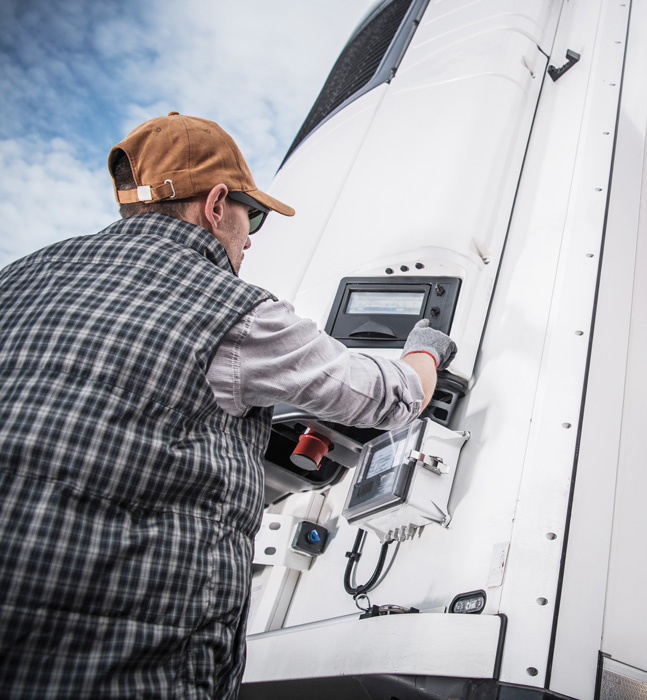Cool Tips on Freeze/Thaw
Processing | APPLIED SCIENCE
According to the latest estimates by marketing research firm MarketsandMarkets, the refrigerated and frozen food transport market was valued at $113.4 billion in 2022 and is projected to reach $160.7 billion by 2027. Refrigerated and frozen foods are multibillion-dollar markets in and of themselves, so it is not surprising that the necessary temperature-dependent transport is also a multibillion-dollar enterprise. A failure at any link in the cold chain can result in serious economic consequences for food companies, including those related to product loss, food waste, food safety, and product quality.
One of the most significant challenges related to storage and transport of refrigerated and frozen foods is freeze/thaw, where temperature fluctuations cause the water content of foods to warm and then crystallize as the temperature drops. Freeze/thaw can adversely affect the product quality of fresh and prepared refrigerated foods through dehydration, discoloration, nutrient degradation, structural breakdown, or moisture migration. Fluctuations in temperature also can introduce a food safety risk during thawing, creating an opportunity for undesirable microorganisms to find safe harbor, grow, and survive.
Here are five top tips to up your best practices game when it comes to addressing freeze/thaw issues and assuring cold chain integrity.
Tip 1: Know the Nodes of Your Cold Chain
A comprehensive understanding of your operation’s cold chain nodes is critical to mitigating freeze/thaw issues with your refrigerated and frozen products. While these vary from operation to operation, end-to-end fulfillment nodes can include over-the-road reefers and air, rail, and sea refrigerated shipping containers. From a track-and-trace standpoint, cold chain nodes include procurement, warehousing, inventory planning and management, holding, and transport.
Take the time to take a deep dive and consider all aspects of the cold chain nodes specific to your operation. What does on-site storage look like? What does the loading of the refrigerated trailers look like? What are the shipping distances? Is the reefer going to an outside or customer warehouse, or are they going to a distribution center? How do the carriers or storage facilities handle product?
Knowing what handling and holding temperature control protocols are in place at each cold chain node can help you identify potential areas of risk where freeze/thaw abuse is likely to occur. For example, if you know that a receiving/shipping dock is not a refrigerated or frozen temperature-controlled area (i.e., product will sit for a time in ambient air), you can proactively put measures in place to reduce freeze/thaw and pathogen growth risks.
Tip 2: Understand Product-Specific Temperature Requirements
While there are differences in some U.S. Food and Drug Administration (FDA) and U.S. Department of Agriculture (USDA) regulations regarding temperature requirements for transport and holding of refrigerated and frozen foods, there are some best-practice level rules of thumb when it comes to temperature ranges for specific types of products. In general, there are four ranges:
- Banana Chain, 54°F–57°F: Processed foods (canned and dried items), fresh tropical fruits such as bananas, pineapple, and citrus, and some vegetables like potatoes
- Chilled, 35°F–39°F: Dairy products, fruits, vegetables, and fresh meat
- Frozen, -4°F–14°F: Frozen meat, beef, poultry, pork, vegetables, fruits, ready-to-cook meals, etc.
- Deep freeze, -22°F to–13°F: Meats and plant-based proteins, frozen dairy products such as ice cream, and seafood such as shrimp and crustaceans.
The key is to know your product and the water content of your products, so you can identify the correct temperatures at which it should be held and transported to avoid freeze/thaw conditions that affect product quality and safety. For example, if your ice cream cone novelty begins thawing at -16°F, moisture is released and starts to migrate. The moisture is absorbed by the dry cone and as the temperature returns to freezing, ice crystals form, which often causes quality problems in terms of texture, appearance, and even flavor and sensory. If a refrigerated chicken product gets too warm, foodborne illness–causing bacteria like Salmonella or Listeria monocytogenes can grow.
Tip 3: Develop a Transportation Safety Plan
A good start in developing this plan is to review guidance and compliance information from the FDA Food Safety Modernization Act (FSMA) rule on Sanitary Transportation of Human and Animal Food, which is designed to prevent practices during transportation that create food safety risks, such as failure to properly refrigerate food, inadequate cleaning of vehicles between loads, and failure to properly protect food. Again, the elements of a transportation safety plan for refrigerated foods many vary depending on the types of products that are shipped or stored, but in general, the plan should cover identified potential food safety and quality risks in your operation’s cold chain. For example, it is a good idea to include a security element designed to identify and mitigate risk of food adulteration or food fraud at all nodes of the supply chain. Temperature control specifications for transport and holding should be detailed in the plan, as well as sanitation and loading/unloading practices and requirements.
For example, sanitation requirements included in the transportation safety plan should specify preventive and corrective measures to reduce the risk of allergen or bacterial cross-contamination during storage, cross-docking, or transit. An integrated pest management program should be detailed in the plan to assure that foods are held or transported in sanitary conditions. Transportation vehicles such as reefer semi-truck trailers should have specific food safety and sanitation requirements pertaining to the practice of backhauling, particularly in cases where the hauler intends to haul raw or nonfrozen proteins or high-risk product components prior to packaged refrigerated foods or ingredients, which may present a microbial hazard.
Tip 4: Use Real-Time Continuous Monitoring Technologies
Simply put, knowing that you have a problem is the first step to solving it. Using real-time continuous monitoring technologies in your cold chain can help your operation identify and address potential freeze/thaw abuse and other food safety and quality issues quickly—before product reaches the retail or foodservice establishment. Real-time data gives your operation the ability to rapidly locate or traceback temperature-abused product that may need to be retracted from commerce for food safety or quality reasons. Continuous temperature monitoring allows you to know the temperature of the product, reefer, or container at all times, which allows you to determine the point at which product may have been compromised.
Many advances have been made in temperature monitoring and control technologies in recent years, especially with the advent of digital transformation and the Industrial Internet of Things (IIoT). Radio frequency identification (RFID) data loggers, time-temperature indicators, and IIoT sensors detect continuously and in real time a variety of parameters, including temperature, humidity, and CO2 concentration, providing enormous amounts of data. Cloud computing and advanced software enable comprehensive data analysis from which food manufacturers can identify trends, root causes of failure, or compromised critical control points to allow proactive corrective action.
Tip 5: Communicate Practical Applications to Mitigate Risk
Once you have mapped out the cold chain nodes, identified product-specific transport and temperature requirements, developed the transportation safety plan, and implemented real-time continuous monitoring technologies, you will have a good foundation for creating practical applications to reduce the risk of freeze/thaw incidents. The first step is to establish good communication with all cold chain players, including shippers, loaders, carriers, and receivers. Conveying and documenting information about your product, its temperature requirements, and the expectations for handling and transporting with each link in the cold chain fosters the kinds of practical applications that mitigate risk, whether it is financial, product quality, or food safety.
Chill Out With Confidence
It’s not for lack of advances in technology that freeze-thaw remains an issue when holding or transporting refrigerated and frozen foods. The food supply chain is complex, and each time a new player, technology, or system is added, the more complex it is and the more challenging to manage. The cold chain is even more complex due to the refrigerated and frozen temperature requirements. The tips detailed here can help your operation institute continuous improvement strategies as some of the fundamental steps in developing a resilient cold chain.
Omnivore Podcast
IFT’s Tracy Fink offers cool tips on how to mitigate freeze/thaw issues in refrigerated and frozen foods.
Learning Objectives
- Learn that freeze/thaw issues are a significant challenge for refrigerated and frozen food processors.
- Get five best practice tips for mitigating freeze/thaw issues during holding and transportation of refrigerated and frozen foods.
- Discover ways to develop proactive freeze/thaw prevention and control strategies.




